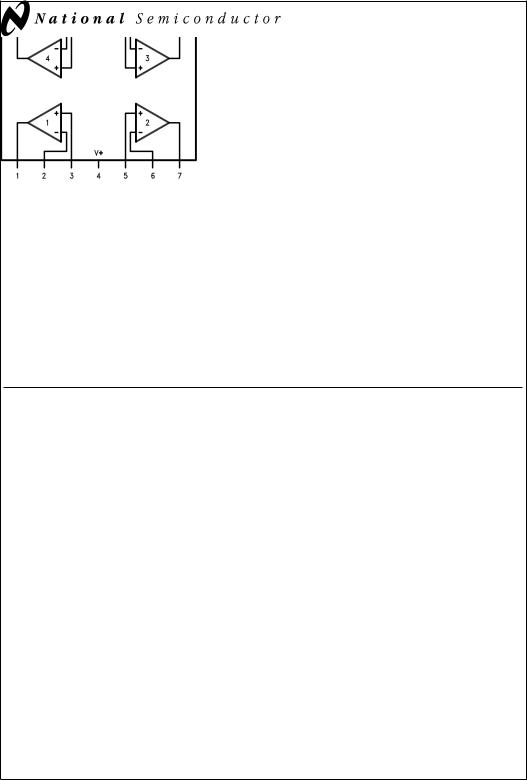NSC LMC660CN, LMC660CM, LMC660AMJ-883, LMC660AIN, LMC660AIMX Datasheet
...
April 1998
LMC660
CMOS Quad Operational Amplifier
General Description
The LMC660 CMOS Quad operational amplifier is ideal for operation from a single supply. It operates from +5V to +15V and features rail-to-rail output swing in addition to an input common-mode range that includes ground. Performance limitations that have plagued CMOS amplifiers in the past are not a problem with this design. Input VOS, drift, and broadband noise as well as voltage gain into realistic loads (2 kΩ and 600Ω) are all equal to or better than widely accepted bipolar equivalents.
This chip is built with National's advanced Double-Poly Silicon-Gate CMOS process.
See the LMC662 datasheet for a dual CMOS operational amplifier with these same features.
Features
nRail-to-rail output swing
nSpecified for 2 kΩ and 600Ω loads
nHigh voltage gain: 126 dB
nLow input offset voltage: 3 mV
nLow offset voltage drift: 1.3 µV/ÊC
nUltra low input bias current: 2 fA
nInput common-mode range includes V−
nOperating range from +5V to +15V supply
nISS = 375 µA/amplifier; independent of V+
nLow distortion: 0.01% at 10 kHz
nSlew rate: 1.1 V/µs
nAvailable in extended temperature range (−40ÊC to +125ÊC); ideal for automotive applications
nAvailable to Standard Military Drawing specification
Applications
nHigh-impedance buffer or preamplifier
nPrecision current-to-voltage converter
nLong-term integrator
nSample-and-Hold circuit
nPeak detector
nMedical instrumentation
nIndustrial controls
nAutomotive sensors
Connection Diagram
14-Pin DIP/SO
DS008767-1
Amplifier Operational Quad CMOS LMC660
© 1999 National Semiconductor Corporation |
DS008767 |
www.national.com |

Ordering Information
Package |
|
Temperature Range |
|
NSC |
Transport |
|
|
|
|
|
|
Drawing |
Media |
|
Military |
Extended |
Industrial |
Commercial |
||
|
−55ÊC to +125ÊC |
−40ÊC +125ÊC |
−40ÊC to +85ÊC |
0ÊC to +70ÊC |
|
|
|
|
|
|
|
|
|
14-Pin |
LMC660AMJ/883 |
|
|
|
J14A |
Rail |
Ceramic DIP |
|
|
|
|
|
|
|
|
|
|
|
|
|
14-Pin |
|
LMC660EM |
LMC660AIM |
LMC660CM |
M14A |
Rail |
Small Outline |
|
|
|
|
|
Tape and Reel |
|
|
|
|
|
|
|
14-Pin |
|
LMC660EN |
LMC660AIN |
LMC660CN |
N14A |
Rail |
Molded DIP |
|
|
|
|
|
|
|
|
|
|
|
|
|
14-Pin |
|
|
|
|
|
|
Side Brazed |
LMC660AMD |
|
|
|
D14E |
Rail |
Ceramic DIP |
|
|
|
|
|
|
|
|
|
|
|
|
|
www.national.com |
2 |

Absolute Maximum Ratings (Note 3)
If Military/Aerospace specified devices are required, please contact the National Semiconductor Sales Office/ Distributors for availability and specifications.
Differential Input Voltage |
±Supply Voltage |
Supply Voltage |
16V |
Output Short Circuit to V+ |
(Note 12) |
Output Short Circuit to V− |
(Note 1) |
Lead Temperature |
|
(Soldering, 10 sec.) |
260ÊC |
Storage Temp. Range |
−65ÊC to +150ÊC |
Voltage at Input/Output Pins |
(V+) + 0.3V, (V− ) − 0.3V |
Current at Output Pin |
±18 mA |
Current at Input Pin |
±5 mA |
Current at Power Supply Pin |
35 mA |
Power Dissipation |
(Note 2) |
Junction Temperature |
150ÊC |
ESD tolerance (Note 8) |
1000V |
Operating Ratings
Temperature Range |
|
|
LMC660AMJ/883, |
|
|
LMC660AMD |
−55ÊC £ TJ £ +125ÊC |
|
LMC660AI |
−40ÊC |
£ TJ £ +85ÊC |
LMC660C |
0ÊC £ TJ £ +70ÊC |
|
LMC660E |
−40ÊC |
£ TJ £ +125ÊC |
Supply Voltage Range |
4.75V to 15.5V |
|
Power Dissipation |
|
(Note 10) |
Thermal Resistance (qJA) (Note 11) |
|
|
14-Pin Ceramic DIP |
|
90ÊC/W |
14-Pin Molded DIP |
|
85ÊC/W |
14-Pin SO |
|
115ÊC/W |
14-Pin Side Brazed |
|
|
Ceramic DIP |
|
90ÊC/W |
DC Electrical Characteristics
Unless otherwise specified, all limits guaranteed for TJ = 25ÊC. Boldface limits apply at the temperature extremes. V+ = 5V, V− = 0V, VCM = 1.5V, VO = 2.5V and RL > 1M unless otherwise specified.
Parameter |
Conditions |
Typ |
LMC660AMD |
LMC660AI |
LMC660C |
LMC660E |
Units |
|
|
(Note 4) |
LMC660AMJ/883 |
|
|
|
|
|
|
|
|
|
|
|
|
|
|
|
|
|
|
|
|
|
|
|
Limit |
Limit |
Limit |
Limit |
|
|
|
|
(Notes 4, 9) |
(Note 4) |
(Note 4) |
(Note 4) |
|
|
|
|
|
|
|
|
|
Input Offset Voltage |
|
1 |
3 |
3 |
6 |
6 |
mV |
|
|
|
3.5 |
3.3 |
6.3 |
6.5 |
max |
|
|
|
|
|
|
|
|
Input Offset Voltage |
|
1.3 |
|
|
|
|
µV/ÊC |
Average Drift |
|
|
|
|
|
|
|
|
|
|
|
|
|
|
|
Input Bias Current |
|
0.002 |
20 |
|
|
|
pA |
|
|
|
100 |
4 |
2 |
60 |
max |
|
|
|
|
|
|
|
|
Input Offset Current |
|
0.001 |
20 |
|
|
|
pA |
|
|
|
100 |
2 |
1 |
60 |
max |
|
|
|
|
|
|
|
|
Input Resistance |
|
>1 |
|
|
|
|
TeraW |
Common Mode |
0V £ VCM £ 12.0V |
83 |
70 |
70 |
63 |
63 |
dB |
Rejection Ratio |
V+ = 15V |
|
68 |
68 |
62 |
60 |
min |
Positive Power Supply |
5V £ V+ £ 15V |
83 |
70 |
70 |
63 |
63 |
dB |
Rejection Ratio |
VO = 2.5V |
|
68 |
68 |
62 |
60 |
min |
Negative Power Supply |
0V £ V− £ −10V |
94 |
84 |
84 |
74 |
74 |
dB |
Rejection Ratio |
|
|
82 |
83 |
73 |
70 |
min |
|
|
|
|
|
|
|
|
Input Common-Mode |
V+ = 5V & 15V |
−0.4 |
−0.1 |
−0.1 |
−0.1 |
−0.1 |
V |
Voltage Range |
For CMRR ³ 50 dB |
|
0 |
0 |
0 |
0 |
max |
|
|
V+ − 1.9 |
V + − 2.3 |
V + − 2.3 |
V + − 2.3 |
V + − 2.3 |
V |
|
|
|
V+ − 2.6 |
V + − 2.5 |
V + − 2.4 |
V + − 2.6 |
min |
Large Signal |
RL = 2 kW (Note 5) |
2000 |
400 |
440 |
300 |
200 |
V/mV |
Voltage Gain |
Sourcing |
|
300 |
400 |
200 |
100 |
min |
|
|
|
|
|
|
|
|
|
Sinking |
500 |
180 |
180 |
90 |
90 |
V/mV |
|
|
|
70 |
120 |
80 |
40 |
min |
|
|
|
|
|
|
|
|
|
RL = 600W (Note 5) |
1000 |
200 |
220 |
150 |
100 |
V/mV |
|
Sourcing |
|
150 |
200 |
100 |
75 |
min |
|
|
|
|
|
|
|
|
|
Sinking |
250 |
100 |
100 |
50 |
50 |
V/mV |
|
|
|
35 |
60 |
40 |
20 |
min |
|
|
|
|
|
|
|
|
3 |
www.national.com |

DC Electrical Characteristics (Continued)
Unless otherwise specified, all limits guaranteed for TJ = 25ÊC. Boldface limits apply at the temperature extremes. V+ = 5V, V− = 0V, VCM = 1.5V, VO = 2.5V and RL > 1M unless otherwise specified.
Parameter |
Conditions |
Typ |
LMC660AMD |
LMC660AI |
LMC660C |
LMC660E |
Units |
|
|
(Note 4) |
LMC660AMJ/883 |
|
|
|
|
|
|
|
|
|
|
|
|
|
|
|
|
|
|
|
|
|
|
|
Limit |
Limit |
Limit |
Limit |
|
|
|
|
(Notes 4, 9) |
(Note 4) |
(Note 4) |
(Note 4) |
|
|
|
|
|
|
|
|
|
Output Swing |
V+ = 5V |
4.87 |
4.82 |
4.82 |
4.78 |
4.78 |
V |
|
RL = 2 kΩ to V+/2 |
|
4.77 |
4.79 |
4.76 |
4.70 |
min |
|
|
0.10 |
0.15 |
0.15 |
0.19 |
0.19 |
V |
|
|
|
0.19 |
0.17 |
0.21 |
0.25 |
max |
|
|
|
|
|
|
|
|
|
V+ = 5V |
4.61 |
4.41 |
4.41 |
4.27 |
4.27 |
V |
|
RL = 600Ω to V+/2 |
|
4.24 |
4.31 |
4.21 |
4.10 |
min |
|
|
0.30 |
0.50 |
0.50 |
0.63 |
0.63 |
V |
|
|
|
0.63 |
0.56 |
0.69 |
0.75 |
max |
|
|
|
|
|
|
|
|
|
V+ = 15V |
14.63 |
14.50 |
14.50 |
14.37 |
14.37 |
V |
|
RL = 2 kΩ to V+/2 |
|
14.40 |
14.44 |
14.32 |
14.25 |
min |
|
|
0.26 |
0.35 |
0.35 |
0.44 |
0.44 |
V |
|
|
|
0.43 |
0.40 |
0.48 |
0.55 |
max |
|
|
|
|
|
|
|
|
|
V+ = 15V |
13.90 |
13.35 |
13.35 |
12.92 |
12.92 |
V |
|
RL = 600Ω to V+/2 |
|
13.02 |
13.15 |
12.76 |
12.60 |
min |
|
|
0.79 |
1.16 |
1.16 |
1.45 |
1.45 |
V |
|
|
|
1.42 |
1.32 |
1.58 |
1.75 |
max |
|
|
|
|
|
|
|
|
Output Current |
Sourcing, VO = 0V |
22 |
16 |
16 |
13 |
13 |
mA |
V+ = 5V |
|
|
12 |
14 |
11 |
9 |
min |
|
Sinking, VO = 5V |
21 |
16 |
16 |
13 |
13 |
mA |
|
|
|
12 |
14 |
11 |
9 |
min |
|
|
|
|
|
|
|
|
Output Current |
Sourcing, VO = 0V |
40 |
19 |
28 |
23 |
23 |
mA |
V+ = 15V |
|
|
19 |
25 |
21 |
15 |
min |
|
Sinking, VO = 13V |
39 |
19 |
28 |
23 |
23 |
mA |
|
(Note 12) |
|
19 |
24 |
20 |
15 |
min |
|
|
|
|
|
|
|
|
Supply Current |
All Four Amplifiers |
1.5 |
2.2 |
2.2 |
2.7 |
2.7 |
mA |
|
VO = 1.5V |
|
2.9 |
2.6 |
2.9 |
3.0 |
max |
AC Electrical Characteristics
Unless otherwise specified, all limits guaranteed for TJ = 25ÊC. Boldface limits apply at the temperature extremes. V+ = 5V, V− = 0V, VCM = 1.5V, VO = 2.5V and RL > 1M unless otherwise specified.
Parameter |
Conditions |
Typ |
LMC660AMD |
LMC660AI |
LMC660C |
LMC660E |
Units |
|
|
(Note 4) |
LMC660AMJ/883 |
|
|
|
|
|
|
|
|
|
|
|
|
|
|
|
|
|
|
|
|
|
|
|
Limit |
Limit |
Limit |
Limit |
|
|
|
|
(Notes 4, 9) |
(Note 4) |
(Note 4) |
(Note 4) |
|
|
|
|
|
|
|
|
|
Slew Rate |
(Note 6) |
1.1 |
0.8 |
0.8 |
0.8 |
0.8 |
V/µs |
|
|
|
0.5 |
0.6 |
0.7 |
0.4 |
min |
|
|
|
|
|
|
|
|
Gain-Bandwidth Product |
|
1.4 |
0.5 |
|
|
|
MHz |
|
|
|
|
|
|
|
|
Phase Margin |
|
50 |
|
|
|
|
Deg |
|
|
|
|
|
|
|
|
Gain Margin |
|
17 |
|
|
|
|
dB |
|
|
|
|
|
|
|
|
Amp-to-Amp Isolation |
(Note 7) |
130 |
|
|
|
|
dB |
|
|
|
|
|
|
|
|
Input Referred Voltage Noise |
F = 1 kHz |
22 |
|
|
|
|
|
|
|
|
|
|
|
|
|
Input Referred Current Noise |
F = 1 kHz |
0.0002 |
|
|
|
|
|
|
|
|
|
|
|
|
|
www.national.com |
4 |

AC Electrical Characteristics (Continued)
Unless otherwise specified, all limits guaranteed for TJ = 25ÊC. Boldface limits apply at the temperature extremes. V+ = 5V, V− = 0V, VCM = 1.5V, VO = 2.5V and RL > 1M unless otherwise specified.
Parameter |
Conditions |
Typ |
LMC660AMD |
LMC660AI |
LMC660C |
LMC660E |
Units |
|
|
(Note 4) |
LMC660AMJ/883 |
|
|
|
|
|
|
|
|
|
|
|
|
|
|
|
|
|
|
|
|
|
|
|
Limit |
Limit |
Limit |
Limit |
|
|
|
|
(Notes 4, 9) |
(Note 4) |
(Note 4) |
(Note 4) |
|
|
|
|
|
|
|
|
|
Total Harmonic Distortion |
F = 10 kHz, |
0.01 |
|
|
|
|
% |
|
AV = −10 |
|
|
|
|
|
|
|
RL = 2 kΩ, |
|
|
|
|
|
|
|
VO = 8 VPP |
|
|
|
|
|
|
|
V+ = 15V |
|
|
|
|
|
|
Note 1: Applies to both single supply and split supply operation. Continuous short circuit operation at elevated ambient temperature and/or multiple Op Amp shorts can result in exceeding the maximum allowed junction temperature of 150ÊC. Output currents in excess of ±30 mA over long term may adversely affect reliability.
Note 2: The maximum power dissipation is a function of TJ(max), θJA, and TA. The maximum allowable power dissipation at any ambient temperature is PD = (TJ(max) − T A)/θJA.
Note 3: Absolute Maximum Ratings indicate limits beyond which damage to the device may occur. Operating Ratings indicate conditions for which the device is intended to be functional, but do not guarantee specific performance limits. For guaranteed specifications and test conditions, see the Electrical Characteristics. The guaranteed specifications apply only for the test conditions listed.
Note 4: Typical values represent the most likely parametric norm. Limits are guaranteed by testing or correlation.
Note 5: V+ = 15V, VCM = 7.5V and RL connected to 7.5V. For Sourcing tests, 7.5V ≤ VO ≤ 11.5V. For Sinking tests, 2.5V ≤ VO ≤ 7.5V.
Note 6: V+ = 15V. Connected as Voltage Follower with 10V step input. Number specified is the slower of the positive and negative slew rates.
Note 7: Input referred. V+ = 15V and RL = 10 kΩ connected to V+/2. Each amp excited in turn with 1 kHz to produce VO = 13 VPP.
Note 8: Human body model, 1.5 kΩ in series with 100 pF.
Note 9: A military RETS electrical test specification is available on request. At the time of printing, the LMC660AMJ/883 RETS spec complied fully with the boldface limits in this column. The LMC660AMJ/883 may also be procured to a Standard Military Drawing specification.
Note 10: For operating at elevated temperatures the device must be derated based on the thermal resistance θJA with PD = (TJ − T A)/θJA.
Note 11: All numbers apply for packages soldered directly into a PC board.
Note 12: Do not connect output to V+ when V+ is greater than 13V or reliability may be adversely affected.
Typical Performance Characteristics VS = ±7.5V, TA = 25ÊC unless otherwise specified
Supply Current |
Offset Voltage |
Input Bias Current |
vs Supply Voltage |
|
|
|
DS008767-25 |
DS008767-26 |
|
DS008767-24 |
|
Output Characteristics |
Output Characteristics |
Input Voltage Noise |
Current Sinking |
Current Sourcing |
vs Frequency |
DS008767-27 |
DS008767-28 |
DS008767-29 |
|
|
5 |
www.national.com |
